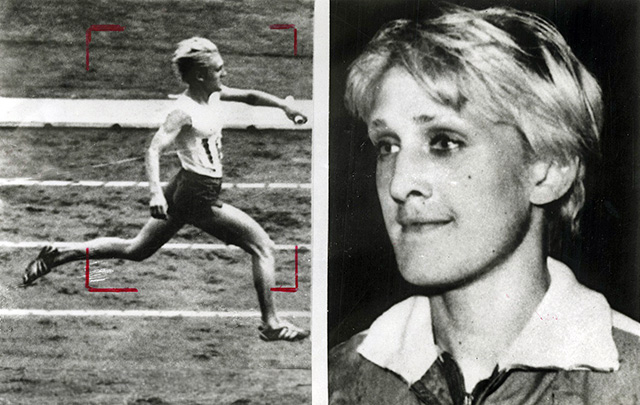Aiming to create a fair competition, the International Olympic Committee first introduced gender testing in 1968, primarily to prevent men from competing in the women's events. As they have discovered over time, there is not always a clear boundary between the two.
Gender testing was first introduced at the Olympics in 1968 for the Winter Games in Grenoble. These tests were compulsory for female athletes, possibly due to fears that male athletes would pose as female athletes and have an unfair advantage over their competitors. However, most cases of men competing as females have been unintentional.
 Polish athlete Ewa Kłobukowska - the first athlete to actually fail a gender test
Polish athlete Ewa Kłobukowska - the first athlete to actually fail a gender test One of the most famous cases, and the earliest, is of Polish athlete Stanisława Walasiewicz (also known as Stella Walsh), who won gold in the women's 100 m at the 1932 Summer Olympics in LA, and silver in the 100 m at the 1936 Olympics. After she was shot dead during an armed robbery in 1980, the subsequent autopsy revealed she possessed male body parts, although she also had female characteristics as well.
The first athlete to actually fail a gender test was another Polish athlete Ewa Kłobukowska. In Tokyo 1964 he won gold in the women's 4x100 m relay and was third in the women's 100 m. In 1967 she was found to have a rare genetic condition (XX/XXY mosaicism) which gave her no advantage over other athletes, but was still banned from competing in Olympic and professional sports.
At the 1976 Summer Olympics, it has been reported that the only female competitor not to have to submit to a sex test was Princess Anne of the UK, who was competing as a member of the UK equestrian team. As the daughter Queen Elizabeth II, such a test was seen as inappropriate. As someone has pointed out, do they really need to test the equestrian riders, as the men and women compete against each other.
At the 1996 Atlanta Olympics eight athletes failed the gender verification tests but were all subsequently cleared by physical examinations.
Mandatory gender testing was officially stopped by the International Olympic Committee in 1999, though there can be evaluation of individual athletes if there is any question regarding gender identity.
Women's 800m runner Caster Semenya from South Africa was required to undergo gender tests after winning the 2009 World Championships in her first international competition. After a period of nearly a year out of competition, she was eventually cleared to compete in London 2012 where she won a silver medal in the women’s 800 meters. In that race she seemed to run a poor tactical race, and was accused by some of holding back so not to win and cause further controversy.
The IAAF have guidelines for gender verification adopted in April 2011 (largely in response to the issues with Semenya), in which female athletes now have to fall below a certain threshold of testosterone. For many female athletes the new eligibility criteria means compulsory hormonal therapy.
For the 2012 Olympic Games, officials implemented a test of testosterone levels. However, unlike past tests which were given to all competitors in women's events, this test will be administered only when the chief medical officer of a national Olympic committee or a member of the IOC's medical commission requests it. The new rules disqualify athletes from women's events if they have testosterone levels in the normal male range, which is 7 to 30 nanomoles per liter in the blood. The top range for women is just below 3 nanomoles per liter. Athletes with complete androgen insensitivity will be allowed to compete.
Following the 2003 Stockholm Consensus, transsexuals (those who have had a sex change from male to female) were permitted to compete in women's events at the Olympics as long they underwent gender reassignment surgery, as well as having legal recognition of their assigned gender and at least two years of hormone therapy.
In 2016, The IOC introduced changes. There are now no conditions placed upon those who transition from female to male gender, making them free to compete. Trans-athletes aiming to compete in female events are not required to undergo reassignment surgery, though they must demonstrate that their total testosterone level in serum has been below 10 nmol/L for at least 12 months prior to their first competition.
Related Pages
- Gender Testing procedures.
- Transgender Olympic Participants
- Women at the Olympic Games
- Science and the Olympics
- Olympic History
Old Comments
- As a competitor in an equestrian event Princess Anne should have been exempt from gender testing as equestrian events are the sole area where men and women compete together. The muscular work is done by the horse. (from Paul H, Aug 2012)
- May I make a suggestion? My suggestion is that you replace the title of your page "gender testing" with "sex testing". This is because, as you know, there is no scientific test for "gender", a psychosocial construct, only for biological sex. I know that the current term used by most sports bodies, regrettably, is "gender testing". I'm not sure why this. It may be only because the elderly male dinosaurs who tend to populate the higher echelons of these bodies, whose first language may not be English, simply fail to understand the difference in meaning in the English language between sex and gender. One has to start somewhere trying to change their outdated attitudes. Hence, I thought I would make my suggestion to you. (from Chris Colenso-Dunne, July 2012)


 Upcoming Events
Upcoming Events